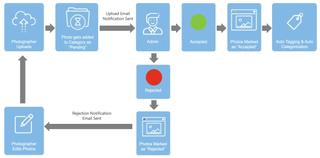DAM Knowledge
The Essential Guide to Digital Asset Management Workflows

Nuala Cronin
Content Manager
7 min read

It’s no secret that creative departments need effective digital asset management workflows in place in order to do their best. That goes for all departments within any organization. But with the high—and ever-increasing—demand for both fast and quality work by creative departments today, setting up creatives for success just makes sense.
The most effective workflows take into account the different kinds of situational needs for an organization. And while every organization has varied, vast and complex use cases, they tend to fit into two broad categories: asset-based, and campaign-based workflows. In this post, we explore the differences between the two types of workflows, and how the right integrations have helped MediaValet clients establish their most effective workflows.
In this post we will cover
What is a Digital Asset Management Workflow?
A digital asset management workflow is a streamlined process for managing, organizing, and distributing digital assets like images, videos, and documents within an organization. It starts with the creation or acquisition of assets, followed by their upload into digital asset management software, where they are tagged with metadata for easy search and retrieval.
After assets are organized within the system, they undergo an approval process to ensure they meet brand standards. Once approved, they are distributed across various channels, facilitated by the DAM’s integration capabilities. As assets become outdated, they are archived or deleted to keep the system current. This workflow ensures that digital assets are securely stored, easily accessible, and consistently used across all brand touchpoints.
A Typical Asset Workflow
Let’s look at a typical workflow and asset lifecycle.

Whether as part of a larger campaign, or a one-off event, the beginning of a digital asset’s life always starts with an asset request in one form or another. This request initiates the entire process, from ideation to distribution.
Once an asset is finalized and has all the necessary approvals, it’s ready for distribution - which can take many forms depending on the specific asset or campaign. At the end of the asset’s life, it’s usually archived, however, for some lucky assets, they get another run or two through the cycle, as they’re repurposed for other campaigns or use-cases.
For smaller teams or projects, this entire cycle may be handled by a small handful of people. But, for larger teams or projects, dozens may be involved and requires a robust system to manage the complex steps, requirements and approvals. In these circumstances, it’s more effective to separate this complex workflow management from your DAM.

Workflows aren’t standard, they’re unique to each organization, team and project, and we find they’re constantly changing and multiplying. Whatever your workflows are today, most likely they won’t be the same, or of the same number, tomorrow. This separation of workflow and DAM often provides a higher level of operational flexibility and scalability.
Types of DAM Workflows
Although there is a wide variety of workflow solutions available today, we break it into two levels:
- Asset-Based Workflows
- Campaign-Based Workflows
The workflow system that will best meet your specific needs will depend on the number of unique workflows that you require across your department or organization and their complexity.
Digital Asset Management Workflow #1: Asset-Based
Asset-based workflows automate and optimize the processes around managing the digital assets themselves. These processes or steps include things like approving assets once they've been uploaded by external parties, adding attributes or metadata, categorizing assets, generating specific renditions, expiring assets, updating and distributing assets - the list goes on and on. These types of workflows focus on preparing the assets to be used as source files or as content.
Asset-based workflows are generally quite simple and tend to be linear in nature, requiring simple triggers and actions to automate. In-DAM workflow features are ideal and cost-effective for addressing these types of asset workflows.
For example, here’s a visualization of an asset-based workflow for a single photographer uploading assets to a company’s DAM. In-app workflows that are available in many DAM systems can help automate components of this process, ensuring the right assets are uploaded the right way (to make them easily discoverable).

Automated events, in this example, include:
- Notifying a named administrator that photos have been uploaded and are ready to be approved.
- Letting the photographer know if any photos were rejected.
- Mandating what attributes need to be added.
- Enabling auto-categorization and tagging.
- Making approved images readily available, in the right formats and sizes, to the appropriate teams or systems.
This simple workflow helps reduce the number of basic tasks that the photographer and administrator would normally have done manually. It also eliminates the chance of human error that could cause bottlenecks, miscategorization, or overall lack of discoverability.
Digital Asset Management Workflow #2: Campaign-Based
Campaign-based workflows, on the other hand, are more complex by nature as they tend to manage the creation of assets, versus asset usage. This involves more people and more complexity.

Campaign-based workflows manage the asset lifecycle of new campaign-related assets from ideation to distribution. This involves coordinating the efforts of multiple teams and departments, and involving multiple levels of review and approval, along with distribution points. The more complex workflows include everything from a local one-off marketing campaign to a global re-branding and everything in between.
When it comes to anything but the simplest asset-based workflows, we recommend using a campaign-based workflow, connecting your DAM with a third-party project management vendor, like Workfront or Wrike. These organizations specialize in workflow and dedicate all their resources and energy to addressing a much wider array of use-cases, from basic to the most complex.
Over the years, we’ve found that integrating MediaValet with Wrike, a project management solution, that it delivers the most value to our customers, both in the short and long term. To this end, to enable and support the unique complex workflows of all our clients, we focus on creating deep integrations with well-known and regarded third-party workflow products. After all, it’s about setting our clients up for success, with the most efficient and effective partners we can find.
Digital Asset Management Workflow Challenges
Managing digital assets through a streamlined workflow offers significant advantages, but it also comes with a set of challenges that organizations must navigate
Integration Complexity:
Integrating various tools and platforms with the DAM system can be challenging, especially when dealing with outdated software or proprietary formats.
Inconsistent Metadata Tagging:
Inconsistent or incomplete metadata can make it difficult to find and retrieve assets, leading to inefficiencies and user frustration.
Approval Process Bottlenecks:
The approval process can become a bottleneck if too many stakeholders are involved or if there’s a lack of clarity about who has final decision-making authority.
System Overload:
As organizations grow and accumulate more digital assets, the DAM system can become overwhelmed. Without proper archiving and deletion protocols, the system may become cluttered, making it harder to locate current, relevant assets.
Addressing these challenges requires ongoing attention to system integration, clear governance practices, and regular maintenance of the DAM environment.
How DAM Software Resolves Workflow Challenges
Digital Asset Management software (DAM) is specifically designed to tackle the challenges that organizations face in managing their digital assets efficiently. By addressing common workflow issues, DAM systems provide robust solutions that enhance productivity and streamline operations.
Simplifying Integration:
Modern DAM software is built with powerful integration capabilities, allowing it to seamlessly connect with other tools and platforms within your tech stack. Whether you're using content management systems, project management tools, or marketing automation platforms, DAM software ensures smooth communication and data exchange across all systems. This reduces the friction caused by incompatible formats or outdated software, making the entire workflow more cohesive and efficient.
Ensuring Consistent Metadata Tagging:
DAM software centralizes and standardizes the process of metadata tagging. With built-in guidelines and automated tagging features, it ensures that every asset is accurately categorized and easy to find. This consistency reduces the time spent searching for assets and minimizes errors, leading to more efficient asset management and better user experience
Streamlining the Approval Process:
To address bottlenecks in the approval process, DAM software offers customizable workflows that clearly define roles and responsibilities. Stakeholders can be assigned specific tasks within the system, and automated notifications ensure that approvals are completed in a timely manner. This clarity and automation eliminate delays and confusion, keeping projects on track and ensuring that assets meet brand standards before they are distributed.
Managing Asset Volume and System Overload:
As digital assets accumulate, DAM software provides robust archiving and deletion protocols to prevent system overload. Automated archiving features ensure that older, less relevant assets are stored efficiently without cluttering the active workspace. Additionally, advanced search and filtering options allow users to quickly locate current, relevant assets, maintaining an organized and efficient system as the organization grows.
More on DAM Workflows
This post is based on a webinar we hosted with Henry Stewart and industry leader, Theresa Regli, on Content Hubs and Workflow. Watch the full recording here, to learn more about DAM workflows, see a campaign-based workflow in action, and hear how MediaValet customer, Reinsurance Group of America, uses MediaValet and Wrike to drive productivity.
MediaValet is a leader in cloud-based digital asset management that helps organizations manage, organize and share their digital assets, improving productivity and increasing ROI.
Related articles




